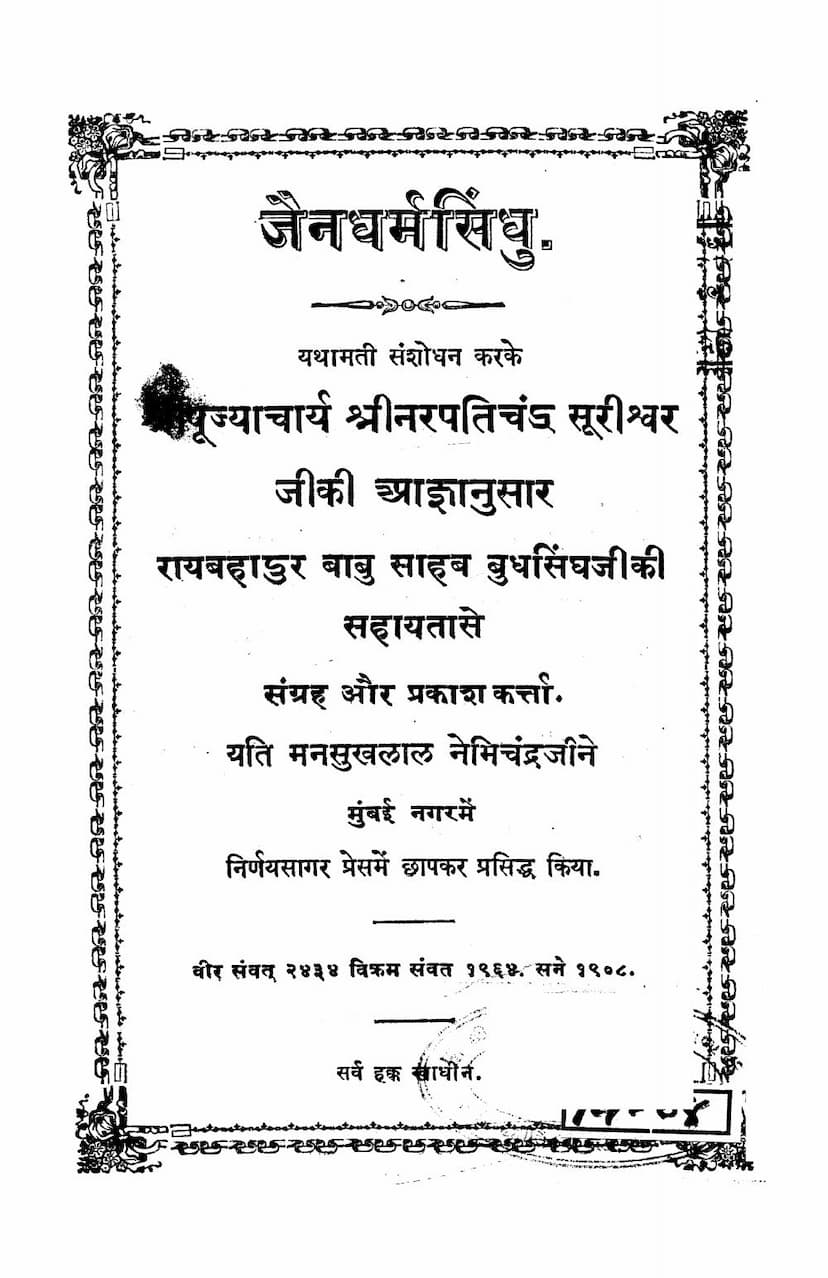Jain Dharm Sindhu
Added to library: September 1, 2025

Summary
Here's a comprehensive summary of the Jain text "Jain Dharm Sindhu" by Mansukhlal Nemichandraji Yati, based on the provided content:
Overview:
"Jain Dharm Sindhu" is a comprehensive Jain religious text compiled and published by Yati Mansukhlal Nemichandriji, with the guidance of Gyacharya Shri Narpatsurishwarji and support from Babusaheb Budhsinghji of Raypura. Published in 1908 (Veer Samvat 2434, Vikram Samvat 1964), the book serves as a guide to Jain principles, rituals, and practices. The text is extensive, covering a wide range of topics related to Jainism, from core philosophical concepts to detailed descriptions of daily observances, rites of passage, and devotional practices.
Key Themes and Content:
The provided text sections highlight the following key aspects of Jain Dharma as presented in "Jain Dharm Sindhu":
-
Introduction and Dedication: The book begins with an introduction and dedication, notably acknowledging Babusaheb Budhsinghji Dudheria as the patron. It includes a brief biographical sketch of Babusaheb Budhsinghji and his brother, Babusaheb Vissanchandji, highlighting their philanthropic contributions and their roles in societal and religious welfare. They were instrumental in renovating Jain temples, establishing charitable institutions, and supporting Jain pilgrimage sites. Their generosity in supporting the publication of this book is emphasized.
-
Jain Practices and Rituals: A significant portion of the text is dedicated to detailing various Jain practices and rituals. This includes:
- Mantras and Stotras: Numerous Jain mantras and devotional hymns (stotras) are presented, such as Navkar Mantra, Panchindriya Sanvaran, Khama Saman, Namothun, Jinvandan, and various stutis dedicated to different Tirthankaras and Jain deities.
- Daily Observances: The text outlines the daily routine for Jain ascetics and laypeople, including prescribed prayers, austerities (tapas), and reflections.
- Pratikraman (Confession/Reconciliation): Detailed procedures for various types of Pratikraman are provided, including Daivasi (daily), Ratri (nightly), Pakshik (fortnightly), Chathmasi (monthly), and Samvatsari (annual) Pratikraman. This section is particularly elaborate, listing numerous types of transgressions (atikram) related to the principles of Jainism.
- Vows and Observances: Descriptions of various vows like Samayik, Posadh, Ayambil, Ekasana, Nivi, Upavas (different types), and Deshavakashi are given, along with their specific procedures.
- Tapas (Austerities): A vast array of tapas is listed and described, indicating the importance of self-purification and asceticism in Jainism. These range from simple fasting to more rigorous practices.
- Chaitra Vandan (Temple Worship): Numerous stotras and procedures for worshiing Tirthankaras and sacred sites like Shikharji, Shatrunjay, and others are included.
-
Life Cycle Rituals (Sanskaras): The text delves into the essential life cycle rituals (Sanskara) for Jain individuals, providing detailed procedures and associated mantras and practices:
- Garbhadhan (Conception Ritual)
- Pumsavan (Fetal Sex Determination and Nurturing Ritual)
- Janma (Birth Ritual)
- Chandra-Surya Darshan (Moon-Sun Viewing Ritual)
- Kshirashan (First Solid Food Ritual)
- Shashti (Sixth-Day Ritual)
- Shuchi Karma (Purification Ritual)
- Namkaran (Naming Ceremony)
- Annaprashan (First Feeding Ritual)
- Karnavedh (Ear Piercing)
- Mundan (Head Shaving)
- Upanayan (Initiation/Thread Ceremony)
- Vidyarambh (Beginning of Education)
- Vivah (Marriage)
- Vratarop (Vow Taking)
- Antya Sanskar (Final Rites)
-
Ethical and Philosophical Teachings: Embedded within the descriptions of rituals and practices are ethical guidelines and philosophical underpinnings of Jainism, emphasizing:
- Ahimsa (Non-violence): The principle of non-violence is paramount, evident in the detailed descriptions of avoiding harm to all forms of life, even at the minutest level.
- Aparigraha (Non-possession): The concept of non-possession is reflected in the guidance on limiting material possessions and renouncing worldly attachments.
- Anekanta (Non-absolutism): While not explicitly detailed in the provided snippets, the comprehensive nature of the text suggests an exploration of Jain's multi-faceted approach to reality.
- Ahimsa, Satya, Asteya, Brahmacharya, Aparigraha: The five Mahavratas (great vows) form the foundation of Jain ethical conduct.
-
Genealogical and Historical Context: The dedication and biographical information provide a glimpse into the historical context of Jainism's promotion and patronage in India, highlighting the role of wealthy individuals in supporting religious literature and activities.
-
Structure and Content: The book appears to be structured in a systematic manner, with chapters (Pariched) and sub-sections, indicated by the detailed table of contents. It covers everything from fundamental mantras to complex ritualistic procedures and philosophical explanations. The sheer breadth of topics, including the vast list of tapas and the detailed description of samskaras, points to its encyclopedic nature.
Overall Significance:
"Jain Dharm Sindhu" is presented as an authoritative and comprehensive repository of Jain knowledge, likely intended for ascetics, scholars, and devout lay followers. It serves as a practical manual for understanding and practicing Jainism in its entirety, reflecting the rich tradition and detailed scriptural heritage of the faith. The compilation by Yati Mansukhlal Nemichandriji, under the guidance of esteemed Acharyas, underscores its importance as a reliable source for Jain teachings and practices.
Note: The summary is based solely on the provided text snippets, focusing on the titles, section headings, and initial descriptions. A full understanding of the book's content would require access to the complete text.